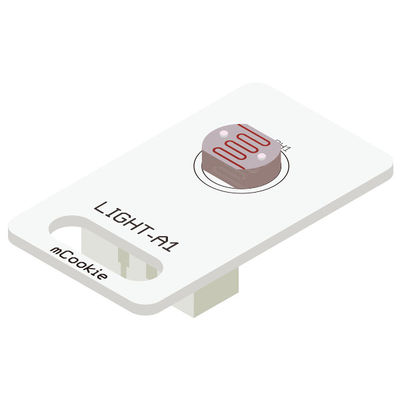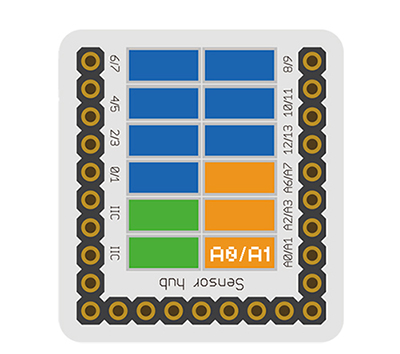Difference between revisions of "Sensor-Light-A1"
(Created page with "{{Language|Microduino-Lightness}} {| style="width: 800px;" |- | 400px|thumb|right| Microduino-Lightness The product number of Microduino-Lightne...") |
(→Basic Functionality) |
||
| (20 intermediate revisions by 2 users not shown) | |||
| Line 1: | Line 1: | ||
{{Language|Microduino-Lightness}} | {{Language|Microduino-Lightness}} | ||
| − | {| style="width: | + | {| style="width: 80%;" |
|- | |- | ||
| | | | ||
[[File: Microduino-Light.jpg|400px|thumb|right| Microduino-Lightness]] | [[File: Microduino-Light.jpg|400px|thumb|right| Microduino-Lightness]] | ||
| − | The product number of | + | The product number of Sensor-Light-A1 is: '''MSDT42''' |
| − | + | Sensor-Light-A1 is a photosensitive brightness detection sensor module. | |
| Line 12: | Line 12: | ||
==Description of the Sensor Pin== | ==Description of the Sensor Pin== | ||
| − | {{ | + | {{ST_Pinout |
| − | | | + | |st_name=Light A1 Sensor |
| − | | | + | |pin3=Analog Input |
| − | |||
}} | }} | ||
| + | |||
==Feature== | ==Feature== | ||
*Resistance photosensitive element, with high sensitivity. | *Resistance photosensitive element, with high sensitivity. | ||
| Line 36: | Line 36: | ||
==Document== | ==Document== | ||
| − | *Schematic diagram: ''' | + | *Schematic diagram: |
| + | *Main sensor: | ||
| + | |||
| + | ==Usage== | ||
| + | |||
| + | ===Basic Functionality=== | ||
| + | The Light Sensor is an analog input sensor. It is able to detect light levels by using a photoresistor. A photoresistor is sensitive to the amount of light and changes its resistance based on light levels. When used in a voltage divider, different voltage levels will be produced based on the amount of light. A Core module can read the voltage value. | ||
| + | {| class="wikitable" | ||
| + | |+Light Sensor State Table | ||
| + | |- | ||
| + | ! Light Amount | ||
| + | ! Value Produced | ||
| + | |- | ||
| + | |No Light | ||
| + | |<200 | ||
| + | |- | ||
| + | |Finger Covering the Sensor | ||
| + | |200~300 | ||
| + | |- | ||
| + | |Ambient Light | ||
| + | |700~900 | ||
| + | |- | ||
| + | |10 Inches from the Sun | ||
| + | |1023 | ||
| + | |} | ||
| + | |||
| + | ===Programming=== | ||
| + | <tab name="Arduino for Microduino" style="width:100%;"> | ||
| + | ==Introduction== | ||
| + | The Light Sensor is used as an analog input pin. Therefore, the '''pinMode''' and '''analogRead''' functions will be used. | ||
| + | ==Key Functions== | ||
| + | *Required Libraries: None | ||
| + | *Key Functions: | ||
| + | ** '''pinMode(pin_number, pin_mode)''' - sets the mode for the pin | ||
| + | ***'''pin_number''' - is the pin number that the sensor is connected to | ||
| + | ***'''pin_mode''' - is the mode to set the pin to. Either '''INPUT''' or '''OUTPUT''' | ||
| + | ** '''analogRead(pin_number)''' - Reads the value of the pin, between 0 and 1023 | ||
| + | ***'''pin_number''' - is the pin number that the sensor is connected to | ||
| + | |||
| + | ==Example== | ||
| + | This is a simple example which outputs the value of the Light Sensor to the serial port terminal. | ||
| + | |||
| + | '''Note''': Important lines of code are highlighted. | ||
| + | |||
| + | <syntaxhighlight lang="cpp" highlight="1,2,3,11,12,18,19"> | ||
| + | //Define the pin the sensor is connected to | ||
| + | //Note: This sensor uses analog read, which means only pins denoted with an 'A' prefix will work. | ||
| + | const int LIGHT_SENSOR_PIN = A0; | ||
| + | |||
| + | void setup(){ | ||
| + | // put your setup code here, to run once: | ||
| + | |||
| + | //Initial serial communication port at 9600 baud | ||
| + | Serial.begin(9600); | ||
| + | |||
| + | //Configure the pin into input mode | ||
| + | pinMode(LIGHT_SENSOR_PIN, INPUT); | ||
| + | } | ||
| + | |||
| + | void loop(){ | ||
| + | // put your main code here, to run repeatedly: | ||
| + | |||
| + | //Perform a digital read and store the value into pin_state variable | ||
| + | int pin_value = analogRead(LIGHT_SENSOR_PIN); | ||
| + | |||
| + | //Print out the current value of the sensor | ||
| + | Serial.println(pin_value); | ||
| + | |||
| + | //delay 10ms between loops | ||
| + | delay(10); | ||
| + | } | ||
| + | </syntaxhighlight> | ||
| + | Copy and paste the code above to the Arduino IDE or | ||
| + | |||
| + | Download the above example: n/a | ||
| + | |||
| + | *Open the Serial Monitor (magnifier glass on top right) and set 9600 baud. This will display the serial output. | ||
| + | </tab> | ||
| − | |||
===Program Download=== | ===Program Download=== | ||
| − | *Download and unzip the program '''[[File: | + | *Download and unzip the program '''[[File:Sensor-Light-A1 Test.zip]]''' |
===Programming=== | ===Programming=== | ||
| Line 58: | Line 134: | ||
===Result=== | ===Result=== | ||
*After download, open the serial monitor. | *After download, open the serial monitor. | ||
| − | *The value displayed on serial monitor reflects the current light intensity detected by the sensor. | + | *The value displayed on serial monitor reflects the current light intensity detected by the sensor. |
==Application== | ==Application== | ||
| Line 64: | Line 140: | ||
It can be used to detect the light intensity, and control the indoor lighting and object shading and so on. | It can be used to detect the light intensity, and control the indoor lighting and object shading and so on. | ||
===Project=== | ===Project=== | ||
| − | * '''[[ | + | * '''[[Usage of Light Sensor]]''' |
| − | |||
==Purchase== | ==Purchase== | ||
| Line 74: | Line 149: | ||
*Front | *Front | ||
| − | [[file: Microduino-Light-F.JPG|thumb|600px|center| | + | [[file: Microduino-Light-F.JPG|thumb|600px|center|Sensor-Light Front]] |
*Back | *Back | ||
| − | [[file: Microduino-Light -b.JPG|thumb|600px|center| | + | [[file: Microduino-Light -b.JPG|thumb|600px|center|Sensor-Light Back]] |
|} | |} | ||
Latest revision as of 20:51, 18 August 2017
| Language: | English • 中文 |
|---|
|
The product number of Sensor-Light-A1 is: MSDT42 Sensor-Light-A1 is a photosensitive brightness detection sensor module.
ContentsDescription of the Sensor Pin
Feature
Specification
Document
UsageBasic FunctionalityThe Light Sensor is an analog input sensor. It is able to detect light levels by using a photoresistor. A photoresistor is sensitive to the amount of light and changes its resistance based on light levels. When used in a voltage divider, different voltage levels will be produced based on the amount of light. A Core module can read the voltage value.
ProgrammingIntroductionThe Light Sensor is used as an analog input pin. Therefore, the pinMode and analogRead functions will be used. Key Functions
ExampleThis is a simple example which outputs the value of the Light Sensor to the serial port terminal. Note: Important lines of code are highlighted. //Define the pin the sensor is connected to
//Note: This sensor uses analog read, which means only pins denoted with an 'A' prefix will work.
const int LIGHT_SENSOR_PIN = A0;
void setup(){
// put your setup code here, to run once:
//Initial serial communication port at 9600 baud
Serial.begin(9600);
//Configure the pin into input mode
pinMode(LIGHT_SENSOR_PIN, INPUT);
}
void loop(){
// put your main code here, to run repeatedly:
//Perform a digital read and store the value into pin_state variable
int pin_value = analogRead(LIGHT_SENSOR_PIN);
//Print out the current value of the sensor
Serial.println(pin_value);
//delay 10ms between loops
delay(10);
}Copy and paste the code above to the Arduino IDE or Download the above example: n/a
Program Download
Programming
Hardware Setup
Result
ApplicationIt can feel the intensity of light around us. It can be used to detect the light intensity, and control the indoor lighting and object shading and so on. ProjectPurchaseHistoryGallery
File:Microduino-Light-F.JPG Sensor-Light Front
File:Microduino-Light -b.JPG Sensor-Light Back |


